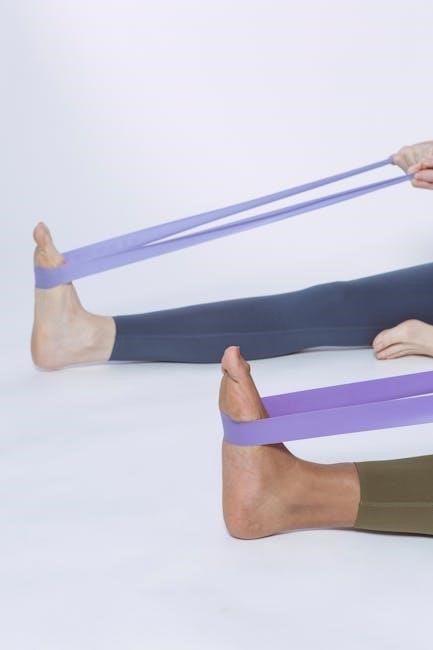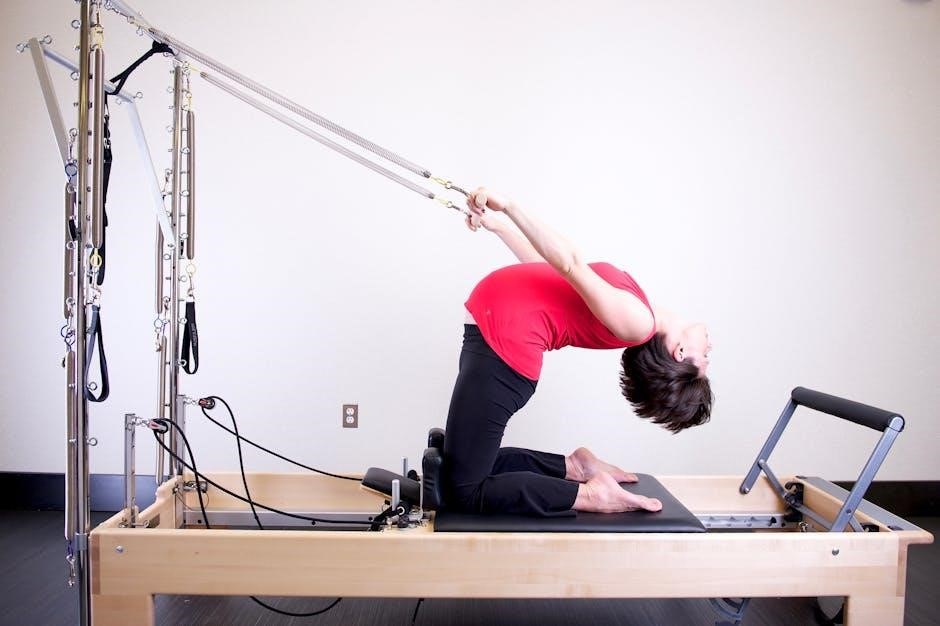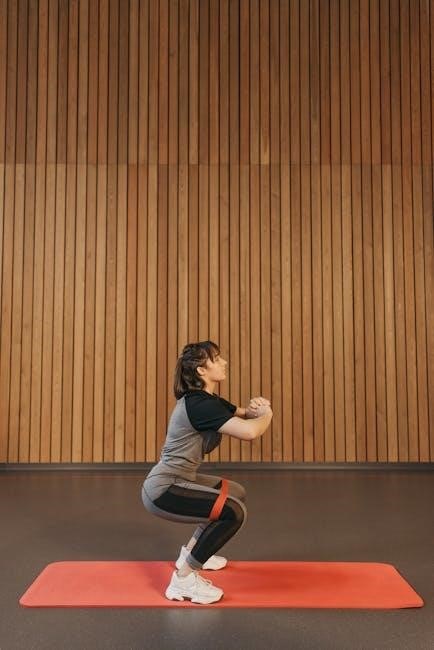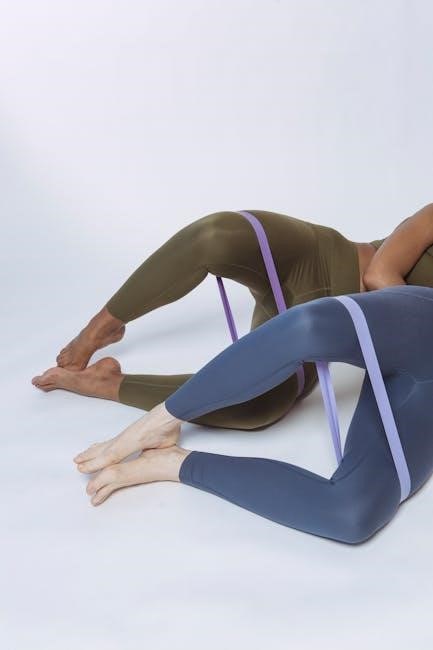
Resistance Band Core Exercises PDF: An Overview
Resistance bands offer a versatile‚ portable‚ and effective way to strengthen your core. A PDF guide provides exercises‚ routines‚ and proper form tips.
Resistance band training is a fantastic way to enhance core strength‚ offering a versatile and accessible approach to fitness. Unlike traditional weight training‚ resistance bands provide constant tension throughout the entire range of motion‚ leading to increased muscle activation and improved stability. They are perfect for all fitness levels‚ from beginners to advanced athletes‚ and can be easily incorporated into any workout routine. Using resistance bands for core exercises promotes similar strength gains to weight training‚ improves balance‚ and increases flexibility. A resistance band is a tiny piece of equipment that can be used in many ways. It is suitable for anyone to use‚ regardless of fitness level‚ making it a perfect choice for workouts. Incorporating resistance band exercises into your routine challenges your abs‚ engages multiple muscle groups‚ and intensifies your results‚ leading to a stronger and more sculpted midsection. With a resistance band‚ you can workout whenever and wherever.

Benefits of Using Resistance Bands for Core Workouts
Resistance bands enhance core workouts by increasing muscle activation and stability. They are versatile‚ portable‚ and suitable for all fitness levels.
Increased Muscle Activation and Stability
Using resistance bands for core workouts significantly increases muscle activation compared to traditional bodyweight exercises. The bands provide constant tension throughout the movement‚ forcing your muscles to work harder to stabilize and control each repetition. This heightened muscle engagement leads to improved strength‚ endurance‚ and overall core stability. Furthermore‚ the accommodating resistance of the bands allows for a greater range of motion‚ which can help to target deeper core muscles that are often overlooked in conventional training. By incorporating resistance bands‚ you can challenge your core in new and effective ways‚ promoting better balance‚ posture‚ and functional fitness. The added resistance not only strengthens the primary core muscles but also engages the smaller stabilizing muscles‚ resulting in a more comprehensive and well-rounded core workout. This enhanced muscle activation and stability can translate to improved performance in various physical activities and a reduced risk of injuries. Moreover‚ the versatility of resistance bands allows for a wide variety of exercises that can be tailored to individual fitness levels and goals‚ making them an ideal tool for anyone looking to improve their core strength and stability.

Essential Resistance Band Core Exercises
Discover key resistance band core exercises to strengthen your midsection. These workouts enhance stability‚ improve posture‚ and boost overall fitness effectively.
Woodchops
Woodchops are a dynamic core exercise that targets the obliques‚ improving rotational strength and stability. To perform woodchops with a resistance band‚ secure the band to a stable anchor point at shoulder height; Stand with your side to the anchor‚ feet shoulder-width apart. Grasp the band with both hands‚ keeping your arms extended. Rotate your torso away from the anchor‚ pulling the band down and across your body towards your opposite knee‚ mimicking a wood-chopping motion. Maintain a slight bend in your knees and keep your core engaged throughout the movement. Control the movement as you return to the starting position. Perform the desired number of repetitions on one side‚ then switch sides. This exercise not only strengthens your core but also improves coordination and balance. Ensure proper form by keeping your back straight and avoiding excessive twisting. The resistance level can be adjusted by using a band with varying tension. Woodchops are an excellent addition to any resistance band core workout‚ providing a functional and effective way to build a strong and stable midsection. Remember to breathe properly‚ exhaling as you pull the band down and inhaling as you return to the starting position.
Dead Bug
The Dead Bug exercise is a fantastic core strengthener that emphasizes stability and controlled movement‚ and using a resistance band can further enhance its effectiveness. To perform the Dead Bug with a resistance band‚ lie on your back with your knees bent at 90 degrees and your arms extended towards the ceiling. Wrap the resistance band around your feet‚ holding one end of the band in each hand; Maintain tension on the band throughout the exercise. Engage your core to press your lower back into the floor‚ eliminating any space between your back and the ground. Slowly lower one arm overhead while simultaneously extending the opposite leg straight out‚ keeping both just above the floor. Maintain the tension on the resistance band and focus on keeping your lower back pressed firmly against the floor. Avoid arching your back or losing control of the movement. Return to the starting position and repeat on the opposite side‚ alternating arms and legs. The key to this exercise is to maintain a stable core and controlled breathing. Exhale as you extend your arm and leg‚ and inhale as you return to the starting position. The resistance band adds an extra challenge‚ requiring you to engage your core muscles even more to stabilize your body. This exercise is excellent for improving core stability‚ coordination‚ and body awareness. Ensure proper form by focusing on slow‚ controlled movements and maintaining a neutral spine.

Creating a Resistance Band Core Workout Routine
Design your resistance band core routine by selecting exercises‚ setting repetitions‚ and scheduling workouts for consistent‚ effective training.
Sample Workout Schedule and Repetitions
Creating a structured workout schedule is essential for achieving optimal results with resistance band core exercises. A sample routine could involve performing these exercises three times per week‚ with rest days in between to allow for muscle recovery. For example‚ you might schedule workouts on Monday‚ Wednesday‚ and Friday. Each session could consist of 3-4 different core exercises using resistance bands. Begin with 2-3 sets of 10-15 repetitions for each exercise. As you get stronger‚ gradually increase the number of repetitions or sets‚ or try using a resistance band with higher tension. It’s crucial to listen to your body and avoid overtraining. Proper form is paramount to prevent injuries and maximize muscle activation. Focus on engaging your core muscles throughout each movement and maintaining a controlled tempo. Remember to warm up before each workout with light cardio and dynamic stretches‚ and cool down afterward with static stretches to improve flexibility and reduce muscle soreness. Consistency and progressive overload are key to building a stronger and more resilient core using resistance bands.
Tips for Proper Form and Safety
Maintaining correct form is crucial to prevent injuries and maximize effectiveness. Engage your core throughout each exercise. Control movements.
Maintaining a Neutral Spine
To protect your back during resistance band core exercises‚ maintaining a neutral spine is essential. This means that your spine should be in its natural alignment‚ avoiding excessive arching or rounding. Before starting any exercise‚ take a moment to find your neutral spine position. Imagine a straight line running from your ear‚ through your shoulder‚ hip‚ and knee. Engage your deep abdominal muscles to support this position. As you perform each movement‚ focus on keeping this alignment. Avoid tilting your pelvis forward or backward‚ and keep your ribcage stacked over your pelvis. If you’re unsure‚ try practicing in front of a mirror to get visual feedback. Remember to breathe deeply throughout the exercise‚ as holding your breath can disrupt your spinal alignment and increase pressure on your back. If you experience any pain in your lower back‚ stop the exercise immediately and reassess your form. It may be helpful to consult with a physical therapist or certified trainer to ensure you’re performing the exercises correctly and safely. A neutral spine will allow you to effectively target your core muscles while minimizing the risk of injury. Prioritize proper form over the number of repetitions to get the most out of your resistance band workout. Remember‚ consistency and attention to detail are key to achieving a strong and healthy core.

Where to Find Resistance Band Core Exercises PDF Resources
Discover online fitness platforms‚ physical therapy sites‚ and official resistance band manufacturer pages for downloadable PDF guides and charts.
Downloadable Guides and Printable Charts
Accessing resistance band core exercise resources is easier than ever with the availability of downloadable guides and printable charts. These resources provide a structured approach to incorporating resistance bands into your core workouts‚ offering detailed instructions and visual aids for proper form and technique. Many websites‚ fitness blogs‚ and online libraries offer free PDF documents that outline various exercises targeting the abdominal muscles‚ obliques‚ and lower back. These guides often include step-by-step instructions‚ recommended sets and repetitions‚ and modifications for different fitness levels. Additionally‚ printable charts can be a valuable tool for tracking your progress and ensuring consistency in your workouts. By having these resources readily available‚ you can effectively plan and execute your resistance band core exercises‚ maximizing results and minimizing the risk of injury. Explore options from reputable sources to find the guides and charts that best suit your fitness goals and preferences. Remember to always consult with a healthcare professional or certified trainer before starting any new exercise program‚ especially if you have any underlying health conditions or concerns. With the right resources and guidance‚ you can unlock the full potential of resistance bands for strengthening your core and improving overall fitness.
Leave a Reply
You must be logged in to post a comment.